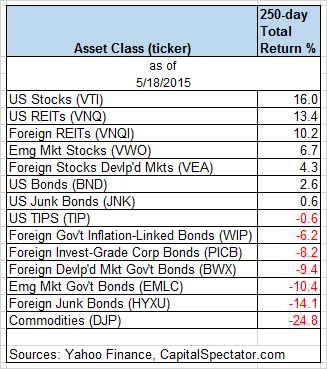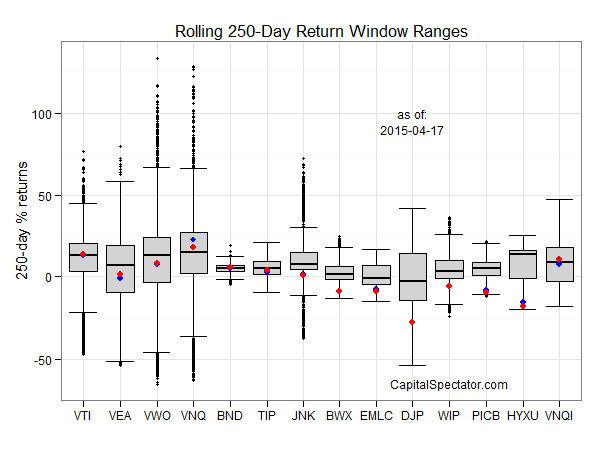U.S. Stocks Are Back In The Lead - ETF Performance Review: Major Asset Classes
The US stock market has regained the pole position for the trailing one-year return (250 trading days) among the major asset classes via our standard set of ETF proxies. Vanguard Total Stock Market (VTI) is ahead by 16% on a total-return basis for the past year through yesterday (May 18). The rebound to the top spot comes at the expense of the former leader in last month’s update—US real estate investment trusts (REITs). Vanguard REIT (VNQ) is still sitting on a solid advance of more than 13% for the past year, but the performance edge has dulled a bit relative to our April review.
At the other end of the return spectrum, commodities (broadly defined) are still in last place, although the depth of loss has been easing lately. The iPath Bloomberg Commodity ETN (DJP) is off by nearly 25% for the trailing one-year period, but that’s slightly less painful relative the red ink in recent weeks.

Here’s a graphical recap of the relative performance histories for each of the major asset classes for the past 250 trading days via the ETF proxies. The chart below shows the performance records through May 18, 2015, with all the ETFs rebased to a year-ago starting-value of 100. US equities have recently wrested the lead (blue line at top) from US REITs (black line).

Now let’s review an ETF-based version of an unmanaged, market-value-weighted mix of all the major asset classes — the Global Market Index Fund, or GMI.F, which holds all the ETFs in the table above. Here’s how GMI.F stacks up for the past 250 trading days through May 18, 2015. This investable strategy is ahead by 5.8% over that span — well below the performance for US stocks (VTI) but comfortably ahead of the 2.6% return for US bonds (BND).

Comparing the median dispersion for rolling 250-day returns for the major asset classes via ETFs suggests that the general rebalancing opportunity has substantially increased for GMI.F vs. recent history. Analyzing the components of GMI.F with a rolling median absolute deviation via one-year returns for the ETFs implies an enhanced potential for adding value by reweighting this portfolio in comparison with recent history. Keep in mind that the implied opportunity for productive rebalancing will vary depending on the choice of holdings and historical time window. Also, any given pair of ETFs may present a significantly greater or lesser degree of rebalancing opportunity vs. analyzing GMI.F’s components collectively, which is the methodology that’s reflected in the chart below. Note, too, that the chart focuses on looking backward. If you’re confident in your forecast for risk and return, the ex ante view of rebalancing opportunity may paint a distinctly different outlook vs. an ex post analysis.

Finally, let’s compare the rolling one-year returns for the ETFs in GMI.F via boxplots for a comparison of performance momentum in the context of recent history. The gray boxes in the chart below reflect the middle range of historical 250-day returns for each ETF — the 25th to 75th return percentiles. The red dots show the current 250-day return (through May 18) vs. its equivalent from 30 trading days earlier (blue dots, which may be hiding behind red dots in some cases). For instance, the chart shows that red-hot performance for REITs (VNQ) from 30 days prior (blue dot) has cooled lately and the current trailing return is slightly below the median (black horizontal line) for recent history (red dot).


Disclosure: None.



